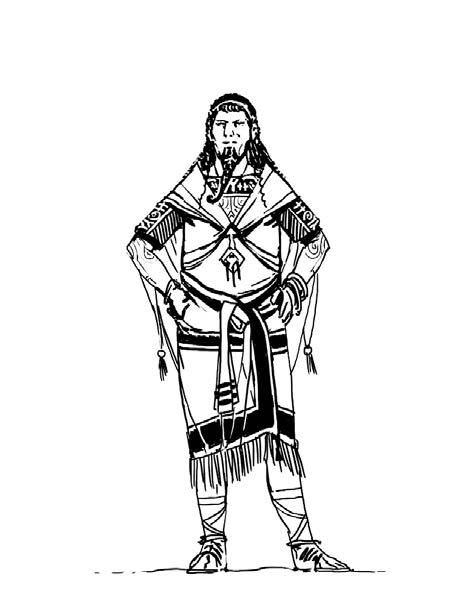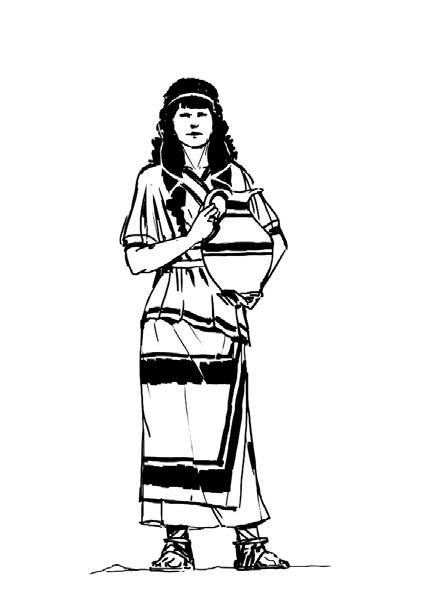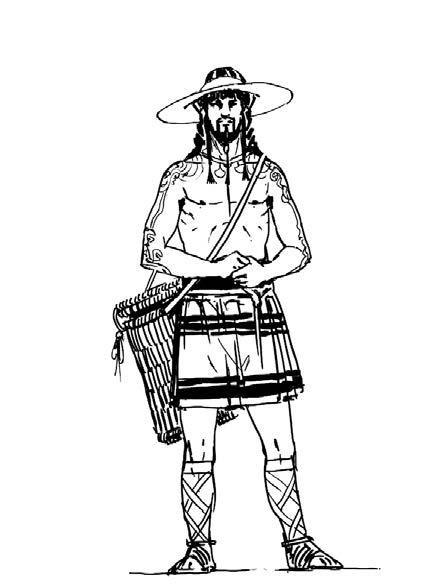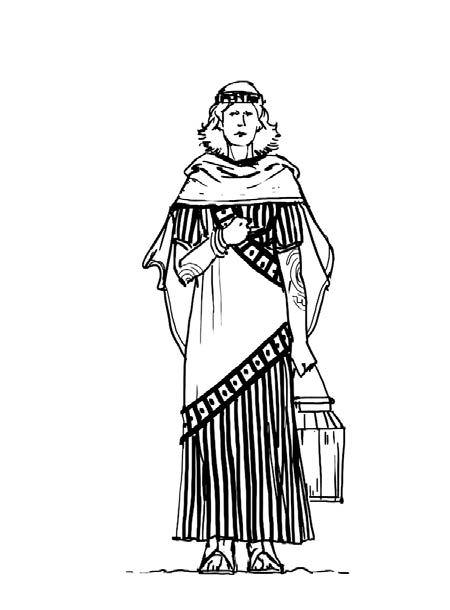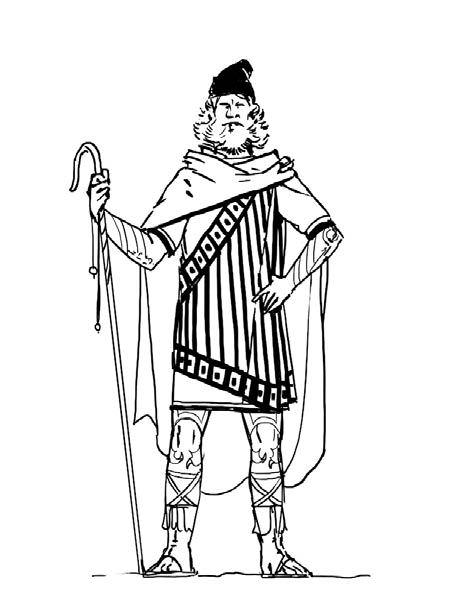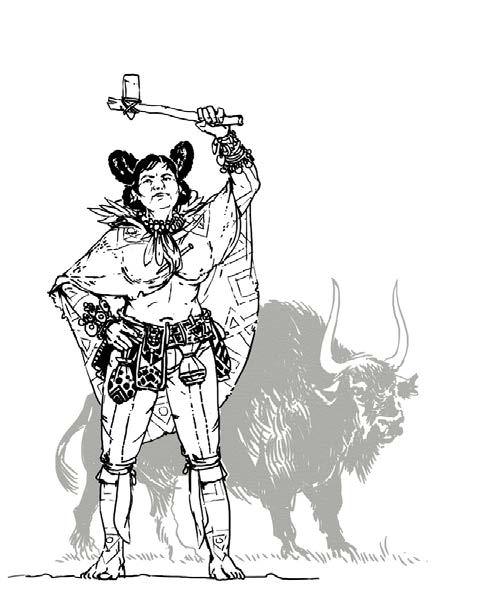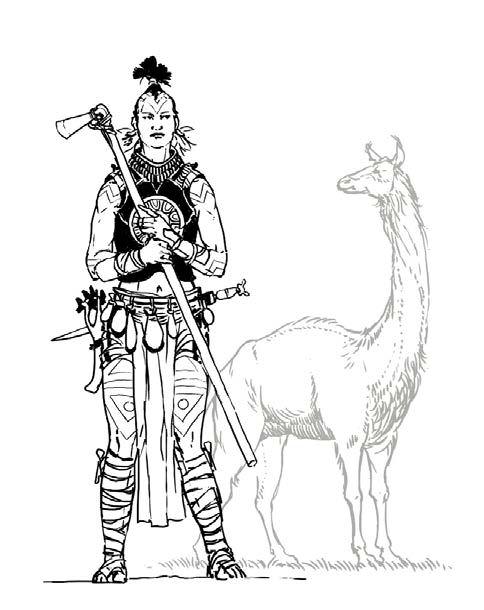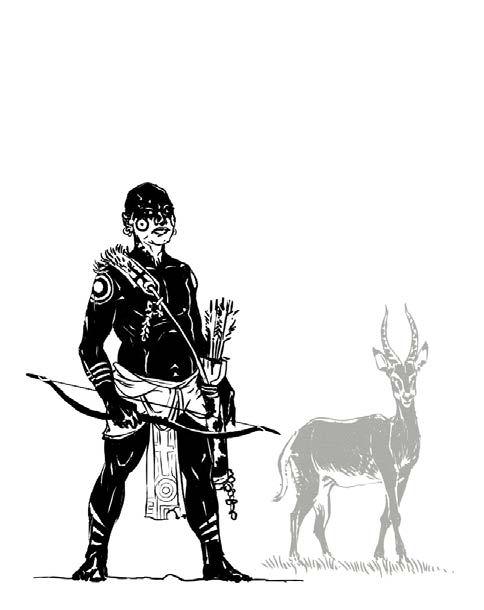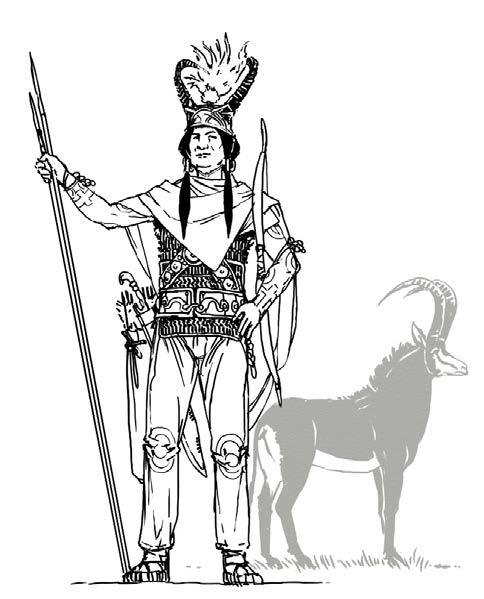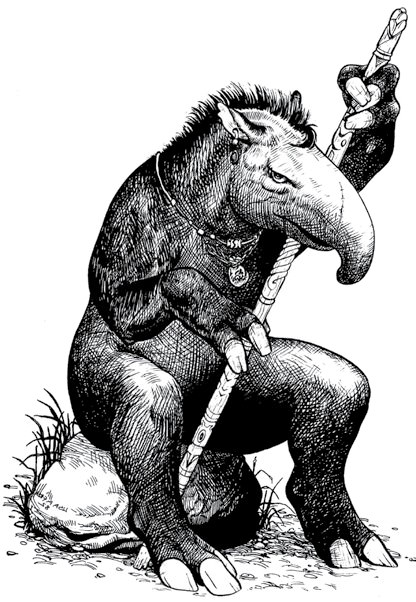HeroQuest Glorantha by Wapole Languray
Intro
Original SA post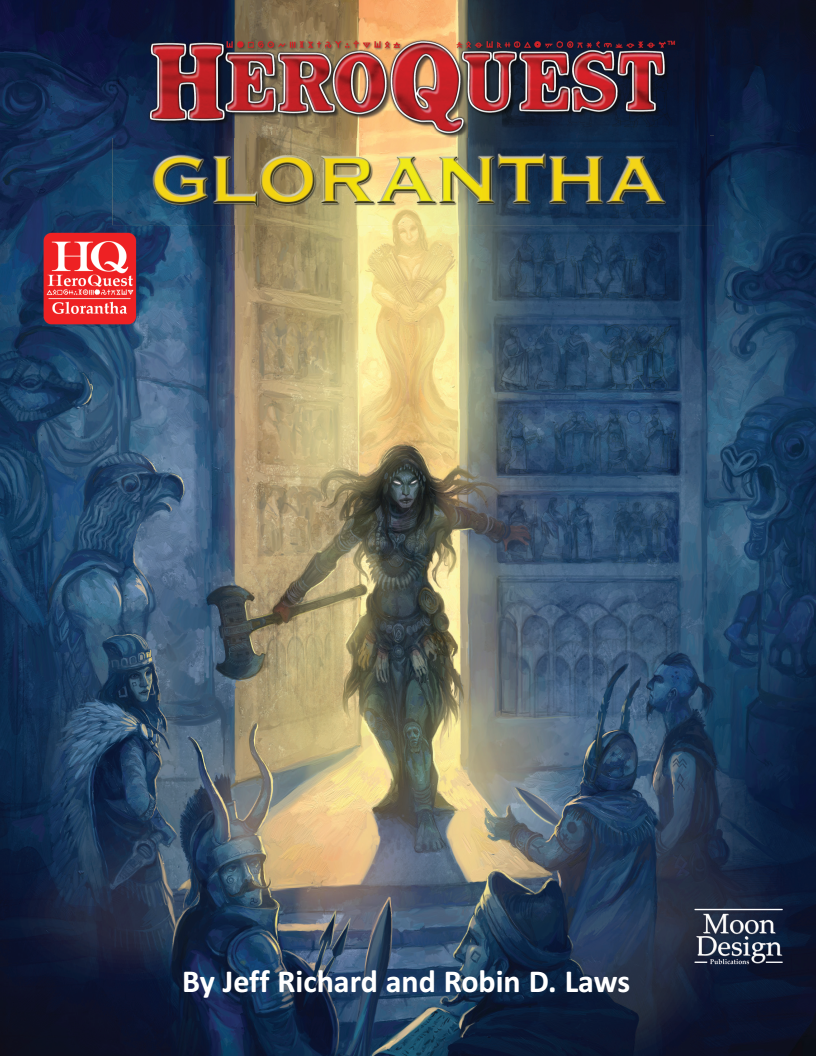
quote:
HeroQuest Glorantha is a roleplaying rules engine designed for play in the world of Glorantha.
The game presents a simple and flexible system allowing Game Masters to make decisions the
way that epic stories and myths do. HeroQuest Glorantha encourages creative input from both
Game Master and players, resulting in an exciting, unpredictable narrative created through
group collaboration. Its abstract resolution methods and scalable character levels allow you
to fully experience the magical world of Glorantha from the mundane to the heroic.
quote:
Version History
HeroQuest Glorantha began its life in 2000, under a slightly different title, Hero Wars. The
game was reissued, in a revised edition, as Heroquest, in 2009. Now in 2015, it is being revised again
to focus fully on Glorantha. The book you hold in your hands is the game’s reappearance
for the setting of Greg Stafford’s classic fantasy world of Glorantha, first glimpsed in 1975 through
Chaosium’s boardgames White Bear and Red Moon and Nomad Gods and now fully detailed in
Moon Design Publications' Guide to Glorantha.
Glorantha
Glorantha is quite possibly the oldest RPG setting in existence, as it definitively predates Dungeons and Dragons in conception with games merely being a preferred method to express the universe. Glorantha is the creation of Greg Stafford, founder of Chaosium Inc (Call of Cthulhu, Runequest, BRPG), game designer, Arthurian scholar (Pendragon) and practicing Shaman.
Glorantha is very different from many traditional fantasy settings. It is firmly Bronze Age not the more traditional Medieval/Renaissance influenced setting. Large emphasis is placed on religion, culture, and mythology as major forces in the world over vague abstracted “faith”. Conflict is more motivated by clashing ideals than simple Good vs. Evil, or by morality and social standards alien to us but infinitely practical to those who follow them. There are no “counterpart cultures” in Glorantha; while there may be influences from many there is no obvious fantasy counterpart of any Earthly peoples.
Tools, Not Rules
HeroQuest Glorantha is not designed to be an all-encompassing reality emulation engine. For simulationist play, Chaosium is releasing RuneQuest Glorantha, which is currently available for early playtest. Instead this game is designed to provide a set of flexible easy to use tools to allow GM’s and players to easily express whatever they desire within play.
HQ:G is explicitly a terrible choice for groups that can be at odds, desire different play experiences, or cannot work together to establish the game. It is best suited for friendly collaborative play based upon mutual trust and cooperation to craft an exciting story for everyone.
Thinking in Story Terms
Instead of acting as a simulationist system that attempts to recreate reality in abstract form, HeroQuest Glorantha is best suited to a style of play that emulates fictional and mythic storytelling with a heavy focus on creating a flowing narrative over a perfectly immersive simulation.
An example is provided: Our brave hero must leap from the top of a ruined building onto the back of a racing horse in order to cut down the foul villain escaping upon its back. In a traditional RPG like D&D, Runequest, Pathfinder, etc. the difficulty and risks of this action would be based upon the physical nature of the situation. How high is the building? How far is the jump? How fast is the horse running? Are there special rules for jumping or similar acrobatics? If he misses, how much damage will it do based upon how far he falls? Things of that nature, attempting to craft a grounded “reality” for the challenge to adhere to.
In HQG this is not the case. Instead you ask a very different series of questions: Would it be more or less fun for him to succeed? If he misses would it ruin the story? If he succeeds would it? Has he been having a rough time and could really use a Big Heroic Moment right now? Or is it time to give the Hero a failure to drive him further and create drama? Is your story the type where leaping onto speeding horses from rooftop something that is reasonable and works, or a stupid dangerous risk? The physical description is there to justify the narrative needs of the scene not to constrain it.
This may sound backwards but it makes sense if you remember all the games you’ve played where a big impressive moment was ruined by chance. How many epic villains where crushed in an instant because of a failed save? How many cool moments missed because someone rolled a 1 and fell down on his face for no reason? In short:
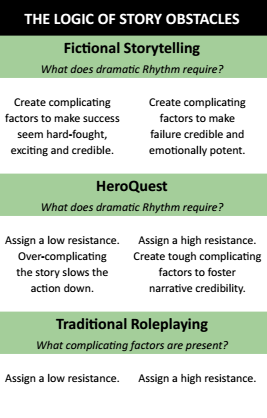
quote:
Maximum Game Fun
When writing, thinking, and gaming about
Glorantha, always ask yourself, “Now, in this
situation what will be the most fun?” and then go
with it. That’s Maximum Game Fun (MGF). Keep
this principle in mind whenever you apply the
rules of HeroQuest Glorantha to any situation.
The World of Glorantha
Original SA post
The World of Glorantha
quote:
Glorantha is not a planet, as is ours, but instead is a slightly bulging, squarish lozenge, like the Earth Rune’s shape. Glorantha floats upon Sramak’s River, the Primal Ocean that encircles the world. The Sky overhead is an off center bowl rotating about the Pole Star which marks the center of the Sky, and is the only stable point in the celestial dome. Between the Earth and Sky is the turbulent realm of the Air gods. Underneath both Earth and Water is the dark, silent Underworld.
Beneath the Sky and the Air, and sitting on top of the Earth is the Middle World – the realm of mortals. It has a northern and southern continent, and many islands.
Beyond the Middle World, there are lands of immensely powerful supernatural races, such as Altinela, Vithela or Luathela. These beings occasionally come to the world of men, but few men ever travel to them. Some are areas of myth, like the Sea of Fire where the sky fell to earth and set everything burning, or the Lands of Dawn and Dusk where the Sun rises and sets each day. Only Heroes can travel to such realms and survive, and from there they can find their way to the very worlds of the gods.
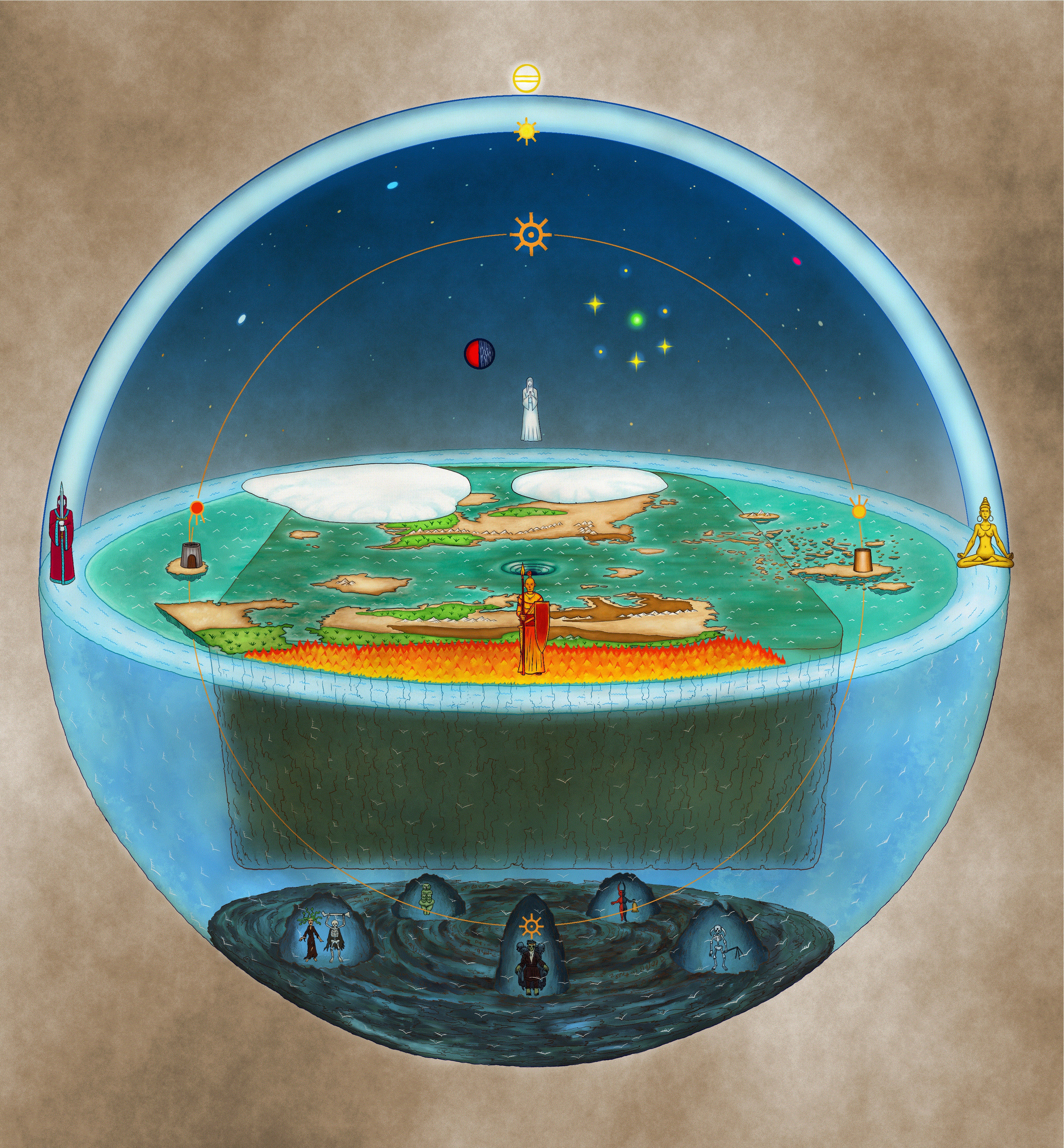
The cosmology of Glorantha is based on mostly mythological concepts instead of scientific ones. Physically from the perspective of the real-world the physical makeup of Glorantha is completely insane, but fits well within Mythological traditions of things like World Trees, Giant Planet Turtles, and Islands in an Infinite Sea.
Above is a representation of the Gloranthan “Globe” though obviously this statement is quite incorrect, but is a useful simplification. To begin, I will simply go through this “globe” giving a brief overview of the things within it. Consider this a “teaser”, a bundle of interesting information presented with minimal context.

Above the Sky Dome, in the realm of the Sky is Dayzatar, God of the Sky, Purity, and Morality.
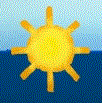
Below Dayzatar is Pole Star. This star marks the center of the sky dome, about which the rest of the heavens rotate. It is associated with several Gods, most commonly Polaris the leader of the armies of the Sky.
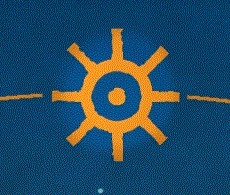
Moving down further we reach The Sun. While there are many solar deities, the Sun itself is commonly held to be the god Yelm, who makes a continuous circuit moving from East to West. The line on either side represents the Sunpath he follows. Yelm spends half his time in the Sky, the other half in the Underworld, which is why there is Day and Night.
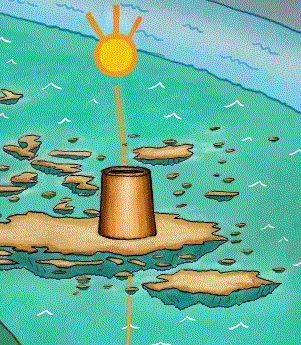
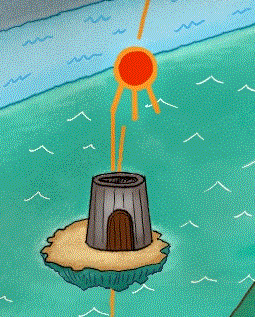
Breaking out pattern, we follow the Sunpath to see the Gates of Dawn and the Gates of Dusk. These serve as the easiest and best known ways to enter and exit the Underworld while still living. The Gates of Dawn to the east open only to allow exit from the Underworld for Yelm’s flaming chariot. They are guarded by a race of golden skinned immortals with voices of pure song. Little is known of it. The Gates of Dusk are to the extreme West and are better known. They are protected by the Goddess of Dusk Rausa and a race of purple skinned immortals known as the Luatha who destroy all trespassers.
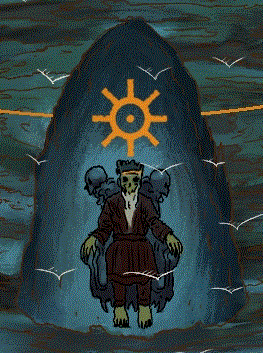
At the opposite end of the Sunpath we find a representation of Yelm as a corpse. Yelm was slain in the Gods War by Death and resurrected, which is why he must spend half the time within the Underworld.
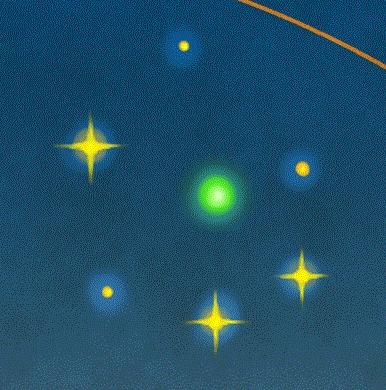
Now we return to the heavens, to reach the Air Realm. Here is Orlanth’s Ring, a strange constellation that sits not in the Sky Dome but in the Middle Air between Earth and Sky. One star, the Dragon’s Head is green while the rest are orange and form a spiral shape. This constellation is the celestial home of Orlanth the God of Air and Storm.
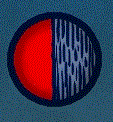
Sharing the Middle Air is the infamous Red Moon. The Red Moon hangs motionless in the Middle Air, rotating about its axis. One half is Red, the other Black. The Red Moon is the Goddess Sedenya, also called Shepelkirt, and rose into the sky of Glorantha only a few centuries ago.
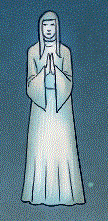
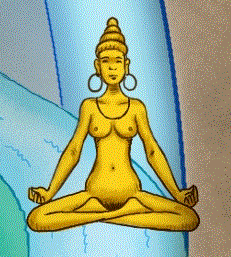
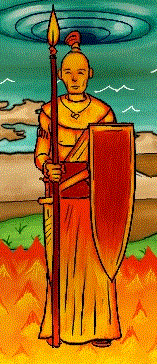
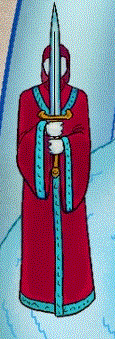
These four figures arrayed about the edge of the world are the Four Directions, who support the Sky Dome and rule the edges of reality.
Now we shall move from the edges inward: The furthest North is covered by Valind’s Glacier, an endless expanse of ice and home of the Gods of Winter and spirits of Cold. The extreme South is the Sea of Fire, where even water burns and the air is poison. The West lies Luathela and East Vithela, explained above in with the Gates of Dawn and Dusk.
The Northern continent of Glorantha is Genertela, and the southern Pamaltela. Between them lies the Eastern Isles, Vormain, Jrustela, and many other islands. At the center of the Middle World is Magasta’s Pool. This is a titanic whirlpool that draws in all the waters of the world, and empties out into the Underworld. While once can reach the Underworld through the Pool, it is unlikely you would survive.
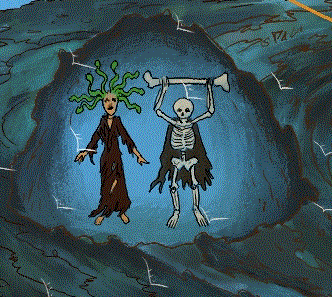
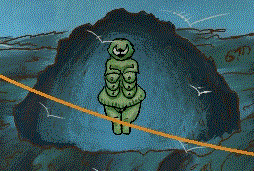
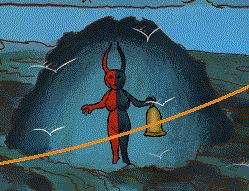
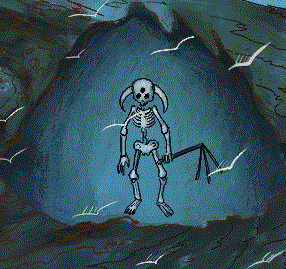
Finally we reach the Underworld. Here are represented several key beings and Gods of this realm. The first figure is Annara Gor or Ty Kora Tek, the Goddess of the Dead. Her priests guard graveyards and prepare corpses. Beside her is Deshlotralas a guardian of the Underworld who wields the Bone of Power. Next is a representation of Kyger Litor, the Mother of Trolls who were first born in the Underworld which they called Wonderhome. The Black and Red figure is Natha, a Lunar Goddess of Balance and Vengeance. The final figure is Deshkorgos the Monster Man, who is guard and warden of the Underworld, responsible for ensuring the creatures of that dark place do not escape.
History
Glorantha was crafted by the gods from the Primal Void of Chaos. At first there was no history, for it was the God Time. This is era of myth and legend where the world was created and shaped, and the gods were born and died and did their mighty deeds. The God Time was ended when the Gods War broke out, a struggle between the gods so extreme that it broke the world and let Chaos in.
Choas nearly destroyed the world, but the Seven Lightbringers undid the damage and returned the Sun God to the sky, banishing the dark and healing the world. To ensure such a thing would never happen again all the gods swore great oaths and compacts to form the Great Compromise which is also called Time. This changed the world and began history.
After Time began was called the Dawn Age, a period of rebuilding as the mortal races repaired the damaged world and filled it with life. This is the era when the Elder Races were strongest and humans were merely one people among many. This world was led by the First Council, made up of humans, non-humans, spirits and gods.
This time of peace did not last, as ancient grudges renewed themselves. The First Council fell to be replaced by the Second Council, a martial empire that grew in arrogance and sought to bring back the God Time. To accomplish this end they birthed Gbaji the Chaos God, who began a 75 year long war which permanently reduced the non-human races and any hope of universal peace. This ended the Dawn Age.
quote:
Gbaji and Arkat
Gbaji's nemesis was the demigod Arkat, who
led the epic struggle to destroy Gbaji that ended
the Dawn Age. Arkat discovered the means of
deliberate heroquesting, and spread his knowledge
among others. During his war with Gbaji, Arkat
underwent unusual transformations that
alienated his followers. After destroying Gbaji, Arkat retired to Ralios
and founded a widespread, peaceful empire.
New Empires and polities rose out of the end of the Dawn Age. Most important and powerful in Genertela and the Dragon Pass region was the EWF or Empire of Wyrms Friends. This empire lasted for 500 years, famed for its close alliance with the dragons and dragon-kin of the pass. The empire eventually fell due to the decadence of their rulers engendering rebellion. The Invincible Golden Horde descended on Dragon Pass seeking to destroy the EWF. At the same instant the Dragonewts turned against their human allies and the two forces annihilated the EWF. The Invincible Golden Horde was not satisfied though, and continued to attack the Dragonewts, looting their cities and smashing their eggs. This raised the ire of the Dragons, who descended on Dragon Pass from across Space and Time. The Dragonkill War got its name from what the dragons did, not what they suffered. Ever since humans have feared dragons.
In 1220 the Red Moon raised into the sky, a newborn Goddess of duality and balance. From her was born the ever-reincarnating Red Emperor who founded the mighty Lunar Empire that spread to conquer every land it could reach. When the empire reached Dragon Pass it found the land resettled by the Kingdom of Sartar. A bitter war was fought, but the nation was eventually conquered in 1602 and integrated into the Empire.
Unlike the other Lunar conquests though, Sartarites did not surrender, and a bitter rebellion was sparked and fought for years against the Lunar occupation.
The Hero Wars
Eventually tiring of the Satarite rebellions the Lunar College of Magic began to construct a Temple of the Reaching Moon in Sartar. This would extend the mystical Glowline, putting the entire Kingdom under Lunar magical dominion and ending any hope of successful rebellion.
In 1625 Sartarite rebels perform a great magic act and awaken a dormant True Dragon that was slumbering under the temple foundations during the temple’s dedication ceremony. This event, called the Dragonrise, led to the temples utter destruction and the death of every priest and priestess and half of the armies there. At the same time, the Lunar city of Pavis will be conqured by barbarian warlord who will lead his army to Dragon Pass.
This warlord is Argrath Dragontooth, a distant kin of the Sartar royal household and refugee from the Lunars. With an army of powerful heroes and magicians behind him he seeks to free Sartar from Lunar control and claim the throne.
This begins the Hero Wars, a long prophesied time of war and strife where the greatest assembly of heroes and demigods in history will descend upon Dragon Pass and change the world forever.
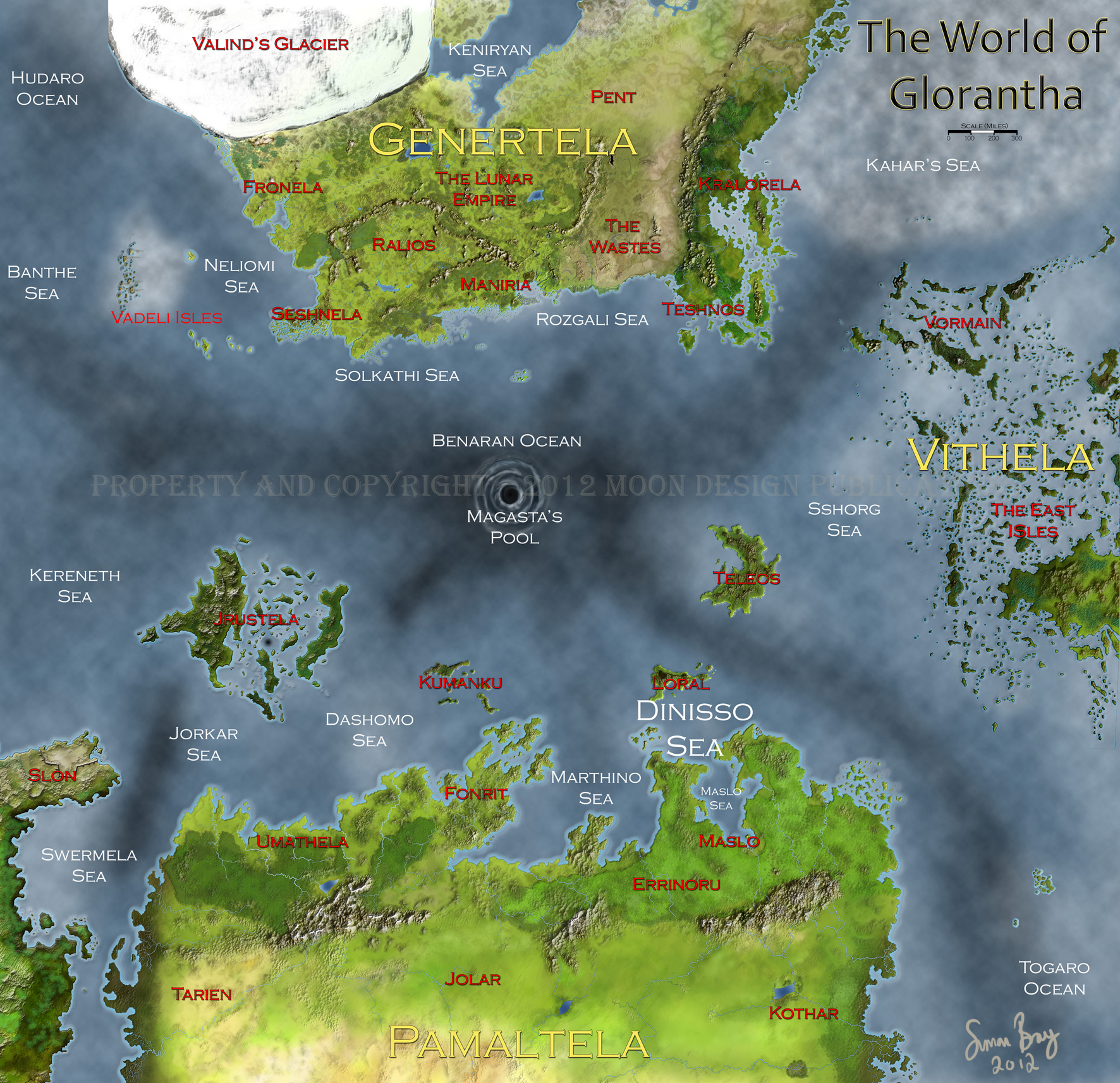
quote:
Genertela is the northern continent of Glorantha. It is largely temperate in climate; its winds generally blow west to east, and ofen from the north during Dark Season. The continent is 3,125 miles long and 1,100 miles wide.
Genertela is the land most heavily inhabited by humans and many regions are urbanized and politically organized. Here the Elder Races have largely been reduced to powerful pockets of resistance surrounding their ancient holy places. A variety of human cultures dominate the better lands.
The continent was badly damaged in the Great Darkness, most seriously when its ruling god, Genert, was destroyed by Chaos. The Wastes astride the continent testify to the physical losses suffered. The magical damage was comparable. Genert embodied important powers of unity and harmony never recovered by the residents of the land.
Pamaltela is the southern continent of Glorantha. The continent is 4200 miles long and 2000 miles wide. Winds generally blow east to west, and occasionally from the hot south. Most of Pamaltela is tropical in climate. Although the Sun comes closer to Pamaltela in the winter and is further away in the summer, that does not mean the southern continents seasons are reversed from those in Genertela, as the summer days are still longer and hotter, winter days cooler and shorter.
This continent also was ravaged by Chaos, but recovered better than Genertela because Pamalt, the ruling god of the Southern Continent, survived. Relative peace and plenty continue in the land, so that even
many humans live a lush, pastoral life. Several Elder Races are still powerful here – dwarves, innumerable
elves, trolls, and a variety of isolated and obscure creatures. Human cites dot the northern coasts.
There are countless islands in the oceans of Glorantha. The East Isles are the largest archipelago in Glorantha, once unified as the continent of Vithela. Humans are populous here, organized into numerous
polities, including a militaristic empire and several powerful commonwealths, as well as an untold number of autonomous islands.
The Runes
Original SA post
The Runes
The Runes are the building blocks of Glorantha. They are both symbols and the actuality of everything in creation. When they are written the symbol possesses some part of the power of the Rune as a whole. The primal Gods of Glorantha were each associated with a single rune, though now the Gods are associated with many each. They are things, beings, abstract powers, symbols, all at once.
Runes are divided by scholars into four categories: Elements, Powers, Forms, and Conditions. Each god is associated with some combination of Runes which define their powers and areas of influence in the world.
quote:
Owners of Runes
Each of the Core Runes originally belonged to a member of the Celestial Court, the assembly of Old Gods who ruled the universe between its creation and the Gods War. Two types of deities were recognized within this assembly; the Powers and the Elemental Rulers. The Celestial Court was destroyed with the coming of Chaos and the Core Runes are now owned by the Great Gods.
The owner of a Rune can do anything within the ambit of that Rune. Consider Orlanth, the owner of the Air Rune; Orlanth and his worshippers can use the Air Rune to fly, control all aspects of their breath, shater stone with a loud shout, call down thunder against a foe, throw lightning, summon a hurricane, make the sky clear of clouds, and so on. Orlanth and his worshippers can potentially do anything with air, storm, or violence.
Other entities have a more limited access to the potentiality of the Rune. Urox has the Air Rune, but is only the master of the Desert Wind. Humakt possesses the Truth Rune, but can only use it for oaths and honor – not for general knowledge.
A few gods (or their specialized subcults) can use a Rune to command a few limited powers of another Rune. For example, the subcult of Barntar can use the Air Rune to plow their fields (something normally associated with the Earth Rune). That power is exceptional and a result of the mythology of that god or subcult; it is outside the conventional ambit of the Rune.
Elemental Runes
The Elemental Runes are the raw lifeless essence of the universe. The physical material of which the world is made.

Darkness
Cold, the Underworld
Also known as First Born, Waker from the Void. Darkness is the first Element, from which the rest are descended. It came from the Primal Chaos and is traditionally the most potent against Chaos. The weapons of Darkness are the rock and the mace, and lead is its metal. Those with this rune are cruel, cold, and secretive.

Water
Fluidity, seas, rivers
Also known as Son of Darkness, Pathway to the Underworld and Supporter of the Earth. Water was the second element, born of Darkness. The waters of the world constantly flow to and return from Darkness through Magasta’s Whirlpool. The weapons of Water are the whip, flail, net, and trident, and quicksilver is its metal. Those with this rune are mercurial and capricious.

Earth
Physical things, agriculture, solidity
The weapon of Earth is the Axe and copper is its metal. Also known as Queen of LIfe, Mother of Many, Supporter of All. Earth is the Third element and fills the central portion of the world, acting as the primary manifestation of the physical. Earth is one of the most widely represented runes, and almost every culture worships some manifestation of its power. Those with this rune are said to be pragmatic, prudent, and worldly.

Fire
Sky, purity, light, stars, the Sky Dome
Also called Crown of the World, Purity of Station, The Distant One, and Emperor of the Sky Dome.Sky was the fourth element, and is held as aloof from mankind. The weapons of Sky are the spear and bow and gold is its metal. Those with this rune are loyal, honest, and pure.

Air
Breath, violence, weather, storm, wind, the Middle Air
Also called Breaker of Laws, Destroyer of Heaven, Father of Fury, Fighter Against Darkness, and Lightbringer. Air is the fifth born, created from violence which upset the order of the world. The weapon of Air is the sword and bronze is its metal. Those with this rune are passionate, proud, unpredictable, and violent.

Moon
Illusion, cycles, balance.
The Moon Rune is only acknowledged as an Element in the Lunar Empire, and only appeared in the Third Age. The Moon Rune embraces Chaos, and works uniquely among all runes.
Power Runes
The Power Runes are organized into opposed pairs. They are the abstract and theoretical runes, representing the immaterial and conceptual.

Harmony
Cooperation, healing
This Rune represents the Divine Harp which separated Order from Chaos, and is held in high regard throughout the world. People with this rune are forgiving, merciful, and peaceful. Its opposite is Disorder.

Disorder
Trickery, trouble
Some believe Disorder was the first Rune, and so is the foundation of the universe. No One knows where the symbol itself is derived from. People with this rune are destructive, reckless, and selfish. Its opposite is Harmony.

Life
Love, plenty, sex
This Rune symbolizes the Ancient Cup, which poured out the world at the beginning of creation. Those with this Rune are generous and lustful. Its opposite is Death.

Death
Separation, conflict, endings
This is the First Sword which brought Death to the world. It is the fate of all living creatures both mortal and divine. Those with this rune are relentless, ruthless, and unemotional. Its opposite is Life.

Stasis
Immobility, permanence, unchanging
This rune is connected with the Dwarves who say it is the first rune that provided the foundation of creation. Those with this rune are stubborn, inflexible, and exacting. Its opposite is Movement

Movement
Change, conflict, mobility
This rune represents a great wheel. Some say it was the first Rune, for without it nothing could change from Chaos. It introduced violence into the world. Those with this rune are adventurous, dynamic, impulsive, and reckless. Its opposite is Stasis.

Truth
Knowledge, writing
This rune represents the torch that the gods used to illuminate Chos. Its constancy and order set creation apart from Chaos. Those with this rune are truthful and observant. Its opposite is Illusion.

Illusion
falsehood, concealment, tricks
The Father of Lies once claimed this was the first Rune, for without it there would be no one to thin they ever were. He refused to explain further. Those with this rune are deceitful and cowardly. Its opposite is Truth.
quote:
Glorantha
The goddess Glorantha was the daughter of the
Twins, the Firstborn. She is the Source of
Creation and the Soul of the Cosmos. Her first
thoughts were the words "I Am," and from that
all of subsequent reality began. With Ouroboros,
she was the Mother of the Powers, and the Empress
of the Celestial Court atop the Spike. During the
Great Darkness, she was shattered and broken as
terror and hate overtook her children. It is widely
believed that Arachne Solara is the incarnation
of Glorantha in Time.
Form Runes
These are the runes corresponding to living things upon the physical plain. Everything has a form rune, but they are rarely a source of power, instead merely defining the physical form of the being in question.

Plant
This is the symbol of the first life upon Glorantha, as plants came before any other living thing.

Beast
Representing the scale of a dragon, as Dragons are said to be the progenitors of all beasts. If a non-beast has this rune, it often means they can take the form of an animal.

Man
This rune defines mortal thinking beings. It represents the progenitor of all races, called Grandfather Mortal or Old Man.

Dragonewt
Only the strange Dragonewts manifest this Rune, making it exceedingly rare. It cannot be manifested with an Elemental Rune, as the Dragonewts draw their power from their own existence.

Spirit
Representing spirits, and other discorporate beings. Shamans and similar spirit-magic users all possess this rune as well.

Chaos
THose descended or corrupted by the entropic force that is Chaos bear this rune. It never manifests alone, always being paired with another form. It can manifest in any being, and even prompt the mixing of opposing powers due to its taint. This rune is taboo in many cultures, and leads to those bearing it being executed if it is discovered.
Condition Runes
These are essentially the “Miscellaneous” runes. They act as clarifiers, modifiers, and just oddities. There are countless specialized and conditional runes, most tied to a single specific concept, nowhere near as broad as the Elements or Powers.

Luck
Fortuity, fate, destiny
This rune is rarely used, except by the Masters of Luck and Death, a special order of magical Warriors native to the holy country. Those with this rune are reckless and fatalistic.

Mastery
Leadership, authority, sovereignty
This is an all-purpose rune, that represents mastery over any aspect of existence. Those with this Rune ware simply greater is some way than their peers. It is the rune of Heros, Kings, and Masters. Those with this rune are proud, just, and authoritative.

Magic
The rune of magic is the rune of communication between the worlds of men, spirits, gods, and others. It regulates and enhances these interactions and defines the supernatural abilities known as “magic”.

Infinity
All, eternity, everything, divine, True Dragons, Illumination
Those with this rune have transcended physical and spiritual limitations: Some gods, the True Dragons,and Illuminated masters manifest it.

Trade
Communication, exchange
Considered a mix between Movement and Harmony, Trade is also called the Issaries rune. It is the symbol of language, speech, trade, roads, travel, currency, and many others. Those with this Rune are fair dealing and open minded.

Eternal Battle
Anti-Chaos
The Eternal Battle rune is the mark of the Chaos-Fighter, and is used to ward against and destroy those possessing the Chaos Rune. Those with this Rune hate chaos, are violent, and prone to rage.
quote:
Other Runes
Several other runes were known in Dragon
Pass in the Hero Wars period, and other runes
are known throughout Glorantha, sometimes
on a regional or cultural basis. These runes include
specializations of the Element Runes, sometimes
called sub-elements, such as Shadow, Cold, Heat,
and Light. Runes linked to specific gods, Heroes,
creatures, races, cultures, or lands are also known.
Creating Your Hero
Original SA post
Creating Your Hero
The book itself has a brief section on on the setting before we get to character creation, detailing a timeline of the setting, some important NPCs, and major locations. I’ve decided to skip it, and come back to it later: The setting is large enough that I would feel like I’m shorting all those elements if I tried to cover them now, and instead I’ll be going into that in-depth later on. So, skipping to Character Creation!
First off, we need to define some vocabulary. The game actually, explicitly does this: Terms first before going into mechanical explanations.
-
Abilities
- 1 Mastery Higher: 75% Chance of Victory
- 2 Mastery Higher: 95% Change of Victory
- 3 Mastery Higher: Don’t Even Bother Chump
- 4 Mastery Higher: Literally Can’t Fail Mathematically
An ability is essentially what your character is made up of and what you roll. It’s anything that lets your hero solve problems and overcome obstacles in the game. Skills, class features, attributes, magic, etc. would all be equivalents in other games.
Keywords
A keyword is a broad category of abilities (Occupation, Culture, Runes) that cover any ability, relationship, possession, etc that falls under it. These are the “umbrella” abilities that give broad competence to your hero.
Breakout Abilities
These are specialized abilities within Keywords, think of them like skill specializations in skills, or more narrow uses of abilities.
Mastery (W)
Represented by the Mastery rune, this is one of the unique parts of the Heroquest system. All abilities in HQ:G are rated from 1-20. If you raise an ability over 20, it does not go to 21, but 1W, 1, Mastery. Mastery in an ability continues to increase, with the number after the Masterly symbol representing how many masteries you’ve racked up. So an ability score of 45 would be written as 4W2. More masteries is better, as the masteries of an opponent or obstacle cancel out, until neither or one of the contestants have no mastery remaining. The exact effect will be highlighted when we get to mechanics, but the book does give us some odds:
quote:
High Level Campaigns
HeroQuest Glorantha can easily handle a campaign where the heroes are full-blown heroes without needing elevated difficulty ratings. With an epic campaign, the usual ability ratings work just fine. If you were playing Harrek the Berserk, a virtual demigod, you don’t need to roll a contest of strength against an ordinary person - Harrek simply succeeds. Instead, drama comes from him trying to fight Jar-eel, a Lunar Hero, and it’s simpler to keep this a contest of 17 vs. 14 than 17W3 vs. 14W3. The latter may seem more impressive, but the masteries cancel out.
Campaign Premise & Theme
The first thing to do, especially in a setting as huge and complex as Glorantha, is to decide… well what you’re doing. The hero's should in some way be connected and have a shared goal, so as to promote adventuring. To this end, they suggest formatting your campaign prompt as: The heroes are X who do Y, i.e. The heroes are members of a clan in Dragon Pass struggling against the oppressive magical might of the Lunar Empire.
This premise sets limits on what and who the players can be, so that the freeform character creation rules don’t break down by having people of wildly different natures stuck together in a party.
Create a Hero As-You-Go
Let’s just outline the steps of character creation real quick: The book itself goes into detail on each step, and this’ll help track which part we’re on in the midst of digressions and complexities.
-
Choose a Concept. Basically your idea of what your character is going to be. Gotta have an idea before starting, a freeform narrative game like this sort of requires it.
Choose a cultural keyword which starts at 13. This is the broad culture of your character.
Choose your community keyword which starts at 13. This defines the more specific community your character is a member of.
Choose an occupational keyword which starts at 17. This is what your character does, either as a career or their main professional skillset.
Choose three Runes. One at 1W, one at 17, and one at 13.
Add a distinguishing characteristic, something that makes you unique or interesting, which starts at 17.
Pick 5 additional abilities. These can be keywords themselves, or breakout abilities from a keyword or Rune. New abilites start at 13, breakouts start at +1 from the keyword or rune they’re under. You don’t have to pick all these at start of play, and can feel free to add them during play as you feel out your character.
Spend up to 12 additional points on keywords, Runes, abilities, etc. You can’t put more than 10 points into any one ability. You can save them for later if you want.
Describe 3 flaws, one of which can count as your distinguishing characteristic.
Come up with a name and appearance!
Pretty simple yeah? Nah, we’re just getting started. Let’s drill down into this stuff!
Your Cultural Keyword
Essentially, whatever your culture is, you can do all the things a normal adult of your culture can do. There are four cultures outlined as examples, though of course you can come up with your own. This is our first introduction to some of the specific cultures of Glorantha, so I’ll be covering them as well!
-
Esrolian
The Esrolians are a highly civilized Orlanthi culture centered in the land of Esrolia. They are organized in large matrilineal family clans, ruled by great matriarchs known as Grandmothers. Each Esrolian city has its own Queen chosen by the clans that live in that city, and the Queen of Nochet, the largest city in the world, is the Queen of all Esrolia.
As home to the largest and wealthiest city in the world, Esrolian’s are more urban, more educated, and more cosmopolitan than any other culture in the area. They are generally more inclined to politics, diplomacy, and trade than warfare. Many Esrolians are literate, and know some degree of sorcery.
The Esrolians primarily worship a pantheon known as the Ten Thousand Goddesses, a large grouping of Earth deities led by Ernalda, the Earth Queen. The primary men’s god is Barntar, a son of Ernalda and god of Farming. The Orlanthi pantheon is also worshipped, though with their roles slightly changed to fit Esrolia’s belief in feminine superiority. They also practice ancestor worship and reverence.
quote:
Esrolian scribe or merchant
This figure is a male Esrolian from the city of Nochet, a scribe or a wealthy merchant. His meticulously groomed beard is plaited into a long narrow shape. He wears kohl to rim his eyes. He wears an embroidered and patterned tunic, and an ornate fringed skirt that goes down no further than his knees.
Heortling
The inhabitants of Sartar, Hendrikiland, Heortland, and Pavis County in Prax. They are a traditionalist Orlanthi culture, organized in patrilineal family clans, that are then members of larger tribal alliances, and in turn large confederations such as the Kingdom of Sartar and the Volsaxi Confederation.
Heortlings are a rural and pastoral people, with the majority of their population living as farmers and herders, with even cityfolk familiar with the trades. They are also a warrior-folk: Both men and women learn to fight, and act as a shield wall as part of the local militia. Few Heortling’s can read though, the cult of Lhankor Mhy has a monopoly on professional scholars.
Heortlings worship the traditional Orlanthi Pantheon, Led by Orlanth the Storm King and his wife Ernalda.
quote:
Heortling free woman
She wears a short-sleeved tunic and a wrap-around skirt
Heortling free man
He wears a skirt and a stout, broad-brimmed hat.
Tarshite
The peoples of Tarsh are similar in many ways to the Heortlings and other Orlanthi peoples, they speak the same languages, have many of the same customs, and live the same way. The primary difference among the rural and lower class Tarshites is the more highly regimented style of their government. Tribal leaders are appointed by the King of Tarsh, and they must pay taxes in goods and coin.
Upper class and urban Tarshites on the other hand are heavily Lunarized. They worship the Lunar pantheon of the Seven Mothers, Hon-eel the Artess, and the Red Goddess. They are heavily influenced by Pelorian styles and culture of the Lunar heartland, especially those who live in and around the city of Furthest. They are an important client state of the Lunar Empire.
quote:
Tarshitefree woman
She wears a long skirt and shawl.
Tarshite free man
He wears a long tunic, cloak, and felt hat
Praxian Tribes
The Praxians are a nomadic culture that lives in the Praxian Wastes, a large arid steppe-region. Each tribe raises and herds a different type of animal, from which they take their name. There are five Great Tribes, Bison, High Llama, Impala, Sable, and Morokanth, and many lesser tribes. They worship the gods Waha, Eiritha, and Storm Bull, though practically most are shamans and animists who worship spirits over gods.
Bison Tribe
Bison Tribesfolk take after their beasts: They are large and brawny folk, who live in massive clans of up to a thousand or more members who travel in huge groups. They are polygynous, with clan Khans and important men having multiple wives. They prefer to charge into battle in mass waves, scorn ranged combat as weak, and prefer heavy lances and thick blades.
quote:
Bison Rider priestess
This female bison rider is brown-skinned and dark-haired. She wears leather leggings and a short wraparound cloak made out of bison hide. She wears nothing underneath the cloak, and her arms are tattooed. At her waist are elaborately decorated leather bags that hold magical medicine bundles with which she appeases the goddess of the herds. She carries a stone-headed axe
High Llama Tribe
High Llama people are tall and lanky, and travel in small groups of 20 to 40 people. THey are the smallest Great Tribe, but the most individually powerful. Their beasts are taller and faster, and their long axes and spears make them deadly fighters.
quote:
High Llama spirit-talker
This High Llama spirit-talker is a tall woman, with olive-colored skin and black hair and eyes. She shaves her heads except for a ponytail at the back. She dresses lightly, wearing little more than a loincloth. Around her waist are many medicine bundles and she has a long and wicked bronze dagger at her side. She wears a leather vest with a bronze chest plate. She carries a very long-handled bronze axe.
Impala Tribe
The Impala people are pygmies, with the average height under 5 feet tall. They are small and slightly built, but are the most numerous of all the tribes. They go into battle nearly naked, trusting to the speed of their mounts while they pelt their enemies with arrows.
quote:
Impala warrior
This impala warrior is short, dark-skinned, and sinewy. He has shaved his head completely, and painted the lower half of his face. He wears nothing more than a loincloth and a belt that carries his essential tools. He is armed with a composite bow
Sable Tribe
The Sable Tribe is different than the other tribes in many ways. Their Herd Queens are more important than their Khans, even in matters of war. They are polygamous, but women choose shared husbands instead of men choosing wives. They are also allies with the Lunar Empire, while other tribes hate all foreigners.
quote:
Sable Rider
This mercenary has black hair and dark eyes. He wears trousers, and a short cloak over front and back. He wears a helmet made of leather and sinew decorated with antelope horns. He wears a corselet of leather and beads.
Morokanth Tribe
The Morokanth are the only tribe of Prax that are not human. Instead, they resemble human-sized Tapir, and their beasts are “Herd Men”, grazing animals that closely resemble humans. They do not ride Herd Men, but instead walk on four legs most of the time, only raising on two when they need to use their hooflike hands. They are vegetarians, and use Herd-men more like simple slaves to gather food for them.
quote:
The Chaos Wars destroyed Prax and there was little food, Waha made the tribes wager who would live off who. In all cases but one the two-legs won, to live off their animals. The four-legged Morokanth were the exception, and now live off their bestial human herds. The two-legs all claim that the Morokanth cheated, and they in turn claim that the two-legs cheated.
Next: More Character Creation
Your Community
Original SA post
Your Community
Community in Glorantha is important. What group you are part of defines your allegiances, ideology, friends, foes, and obligations. Clans, Tribes, Nations, Units, Cults, all push and pull on who your are.
You can have multiple relations of course, but always have to have at least one: No man is an island. They can grant aid, allies, contacts, resources, and just good advice. A hero with no community to be a part of is going to have a very very rough time of it.
Your rating in your community is indicative of how you can leverage that community to solve problems. A high rating may indicate a deep and powerful connection to a small community, or a relatively small influence in a large one. A clan-chief is incredibly important to his clan, but is only one part of a tribe, and a very minor part of the entire kingdom.
One important feature of communities is that they are a two way street: You must support, aid, and take part in your community or else face severe consequences. These come not just from rolling, but as a result of pure roleplaying choices.
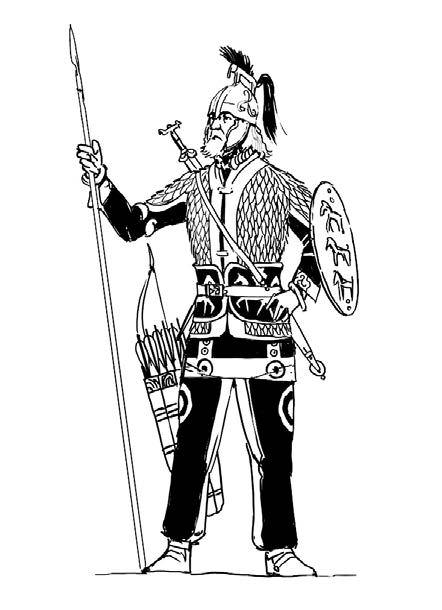
Grazelander Heavy Cavalry
This Pure Horse People aristocrat wears a long coat made of bronze scales. Under that he wears riding trousers. He wears a bronze helmet that was likely made by Pelorians.
He is armed with a long bronze slashing sword (probably made by the Sartarites), which is slung on his back, a thrusting spear, and a composite bow. He has a small round shield faced with bronze.
Your Occupation
The best way to think of this is your class. This is what you DO, what your professional training is in primarily. Several sample Occupations are listed, which I’m not going over. They aren’t exactly unique or flavorful, so I’m skipping them. If you’re curious, here’s a quick list: Bandit, Fisher, Crafter, Famer, Healer, Herder, Hunter, Sailor, Merchant, Scribe, Scald, Noble, and so on you get the idea.
quote:
Standard of Living
Each occupation has a standard of living associated with it. An occupational keyword can be used as a broad ability to overcome obstacles involving wealth. The standard of living determines the credibility of using that ability against a particular obstacle (see the section on Credibility, page 113). It is not credible for a Thief to use her occupational keyword to try to acquire enough farmland to support a free farmer and his household! She would have to have some other ability (like a Chest of Coins).
Poor: This occupation provides just enough to survive. It is a desperate and meager existence. Using Poor occupations to overcome obstacles involving wealth is usually not credible.
Common: This occupation provides the standard of living to be a full member of the community. Such people usually have their own dwelling place, clothes for both everyday and special occasions, and enough land and livestock to support them and their family or its equivalent in goods. Common occupations can be credibly used to overcome obstacles that might have a value of 50 Lunars or less.
Prosperous: This occupation provides substantial surplus wealth. Such people own land they do not have to work, animals they do not have to herd, fine clothes and jewelry, riding animals, and more. Prosperous occupations can credibly be used to overcome most wealth-related obstacles.
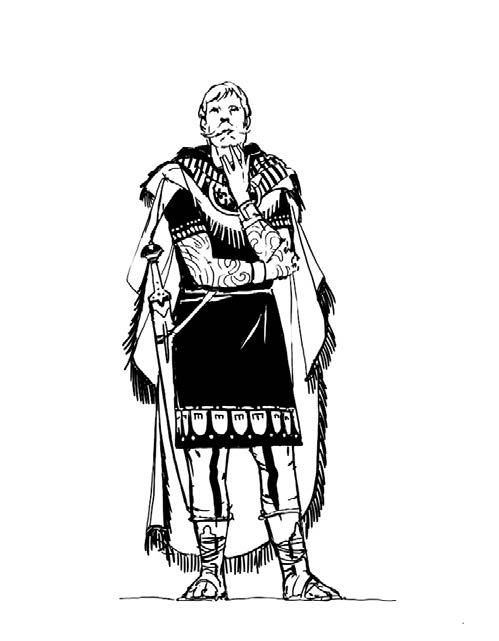
Sartarite Noble
This chieftain or petty king wears a long tunic that goes down to his knees over riding leggings. Over this he wears a long fringed cloak that goes down to near his ankles
Your Runes
The Runes you choose determine the nature of your magical power and set the baseline nature of your personality. They represent your inner being, your soul as it were, an expression of your true innermost being.
To start you select three runes: An Elemental Rune, a Power Rune, and a third of your choice. The third can be a Power, Condition, or Form rune, but you cannot have a second elemental rune at creation, and cannot pick a Power Rune that opposes your existing choice. There are also the Spirit and Law runes, which are required if one wishes to use Spirit Magic or Sorcery, but that will be covered later when we get to magic.
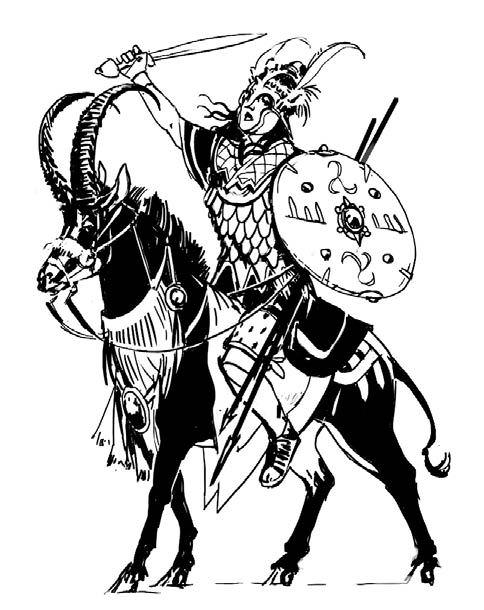
Warrior
This professional warrior is equipped by a clan chieftain and serves as one of his bodyguards. She wears a bronze helmet with cheek pieces and a nose guard. She wears bronze greaves, short cuirass of boiled-leather, and short trousers of leather or wool beneath her skirt. Like many warriors in Dragon Pass, she rides a Praxian beast (a sable antelope)
quote:
When Do I Get My Runes?
Your Runes are a part of you, but you are awakened to them with your adulthood rites that make you a full member of your community. At adulthood, your three most significant Runes are chosen. A child cannot do Rune magic.
In Dragon Pass, Heortland and Esrolia, most men are strongly associated with the Air Rune and most women are strongly associated with the Earth Rune; these runes are almost always one of your three most significant Runes. Normally, you can only have one elemental Rune. The Tarshites are largely the same, although the Lunarized cities have a significant minority of people associated with the Moon Rune.
In Prax, each tribe is associated with a Rune. The Bison Tribe is associated with the Air Rune. The Impala Tribe is associated with the Fire Rune. The High Llama Tribe is associated with the Water Rune. The Sable Tribe is associated with the Moon Rune. Lastly, the Morokanth are associated with the Darkness Rune.
Runes and Personality
Runes have an effect on your personality, and are assumed to be true for your character. This acts as both a guide to roleplaying, and a tool for your gamemaster to use. A hero can be tested if they try to act contrary to one of their runes, weakening their bond with it if they successfully act counter to their nature. But, in the same way one can receive bonuses and augments when acting in accordance with your Runic nature.
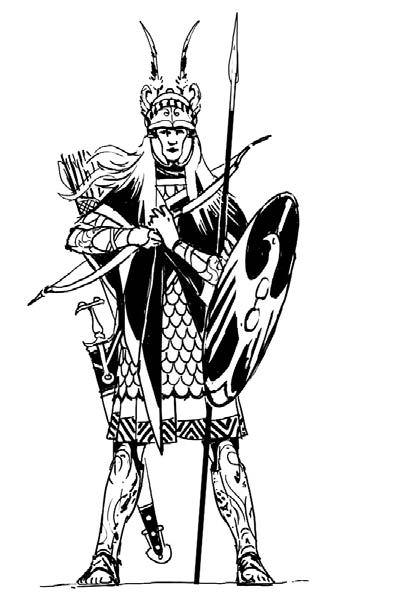
Warlock
This warlock is a member of one of the magical warrior societies that serves Prince Argrath. Like the thane, she is trained to fight from horseback, and is heavily tattooed. This warlock wears a hauberk of bronze scales with shoulderpieces. The ornately decorated helmet has a crest and side feathers, and even bronze wings.
Runes and Time
Runes are also associated with the Gloranthan calendar, with each season, week, and day associated with a Rune or combination of Runes that may affect magic. This means that runes corresponding to the current time of year are strengthened, while runes opposed to that are weakened. This is of course optional. If you want to ignore the calendar feel free, or just use the date effects when it would be relevant, not every time magic is used.
How do I get New Runes?
Yes, you aren’t stuck with the runes you start with! You can get them through what the game is named after: Heroquests! One must find and perform an appropriate Heroquest in order to gain or change a Rune. A major example is that all Orlanthi Kings must have the Mastery Rune, and if they do not must perform a heroquest in order to obtain it.
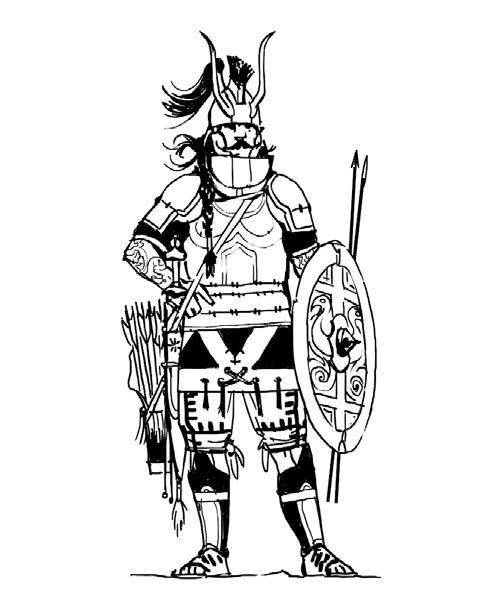
Thane
This noble warrior is the companion of a petty king. He wears a bronze bell cuirass and a decorated bronze helmet with cheek pieces and feathered crest. His exposed throat is covered by a crescent shaped silver-plated gorget, decorated with bands of relief ornamentation.
Choosing abilities
Now, you get 5 freeform abilities to choose! These can be totally new keywords, or specialized “breakout” abilities that act as modifiers of a keyword. Obviously, this is a VERY open category, and leads into one of the things I like about HeroQuest!
See, most games with this sort of freeform character creation system are really really bad at giving you an idea of what a useful or good ability or skill actually is. See 13th Age’s issues with Backgrounds, or Numenera’s crap half-assed skill system. HeroQuest on the other hand, is very interested in making sure you have a full breadth of options ready to pick from and know what a good way to mechanically build them are.
One big piece of advice is to avoid superlative abilities. “Veteran Swordsman” is a good Ability. “World’s Greatest Swordsman” is not, because suddenly you have a disconnect from what’s on your sheet and what’s happening in game when you inevitably lose a sword fight at some point. Abilities should be descriptive, evocative, flexible, and help paint a picture of your character without putting up barriers to the fiction.
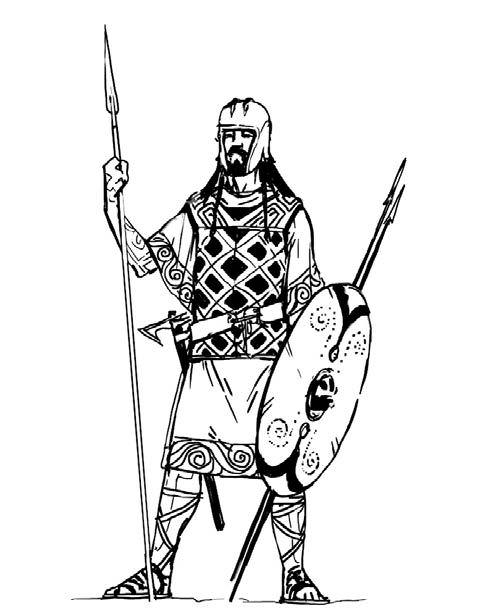
Dragon Pass militia
In Dragon Pass, all free men (and women members of martial cults) are expected to follow their chief into war. This typical militia member wears an open helmet made of leather or bronze and a leather or quilted-wool jerkin to defend his torso.
Flaws
Characters get up to 3 flaws free. These represent negative aspects of your character, like personality traits, social stigmas, physical weaknesses, dependent or adversarial relationships, or even magical effects like curses. It’s important to note that these are totally optional, and are just there to add flavor to your character. They can be used in a contest to make your character act along with the flaw, be used to justify penalties, etc. but mainly they’re a flavor and roleplaying thing that doesn’t weaken the game at all to leave out.
Of note, the book explicitly states that flaws can only hinder the players. No getting a free flaw and trying to spin it into a positive to use as an ability.
Assigning Ability Ratings
Of course this all fine and dandy, but the Ability name is only part of it: It says WHAT you can do, but the ratings determine how GOOD you are at doing it. Once you have your abilities selected you get to spread 12 points around to boost them as much as you want, or you can keep them for later. Each point raises an ability by 1, but you cannot boost any by more than 10 points to keep you from just dumping everything into one keyword and breaking any sort of progression or power curve totally.
During play, Runes and Keywords will take 2 points to raise, due to their breadth. Breakout abilities only cost 1. Which is such an elegant solution and way to incentivize specialization without making breadth of skill a bad idea.
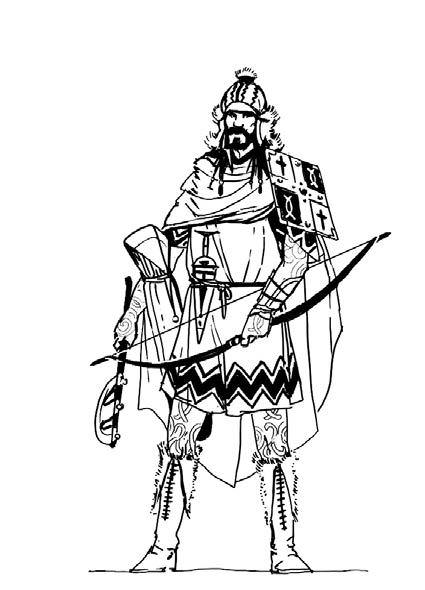
Tarsh Exile
This Tarsh Exile is an archer; light infantry feared for their ambushes in the rugged terrain around Kero Fin Mountain. The archer wears a patterned wool tunic, and a heavy wool cloak. He wears fur-lined boots, laced up the front, for warmth. He has a composite bow similar to the Grazelanders, although the Exiles are largely infantry. The Exile has an ornamented quiver, and carries a bronze-headed axe. He has a square, leather covered wooden shield
Equipment
This is almost always an issue in narrative games: How do you handle loot? Because we all know gamers freaking LOVE gearporn. They LOVE shopping lists and twiddly stats and opening chests for sweet swag. Or at least it seems like they do based on how many books obsess over the stuff. HeroQuest obviously does things differently, but in a good way that still can make equipment important and interesting, without it being over complicated or vague and uninteresting.
First, you are assumed to always have access to all the equipment and gear that your abilities say you should be. A Mercenary will reasonably have armor, sword, shield, rations, a pack, waterskin, etc. unless some event happened that explicitly stripped the character of such possessions.
For equipment to get a feature slot on your character sheet, you build it as an ability, just like anything else. The important thing is that you make sure said equipment is able to solve more than one problem. If your sword is just a generic sword and only really useful for stabbing people, than it should be covered by some other ability you use to fight with and not take up a whole ability by itself. Instead it should be an item with flexible usage, magical associations, or social cache that lets it justify the breadth and power of an ability.
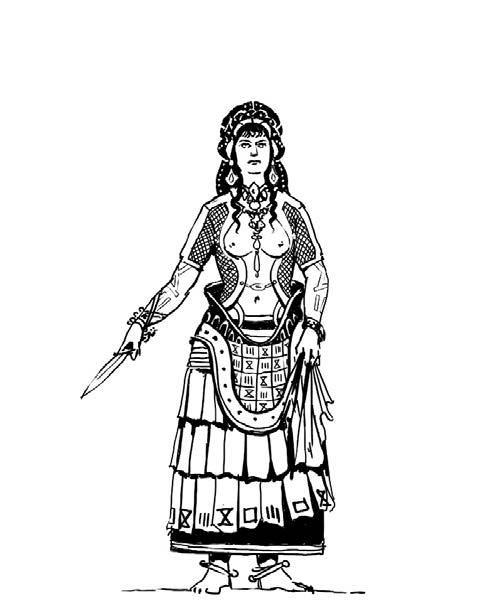
Esrolian Priestess
This priestess wears a tight green bodice that is opened to below her navel to reveal her breasts. She wears a flounced and pleated bell-shaped skirt. Around her neck, she wears a necklace of emeralds. She is barefoot, so that she might have direct physical contact with the Earth. Earth temples throughout the Orlanthi lands (and even beyond) have adopted the Esrolian style.
Magic Items
Yes there are magical items in Glorantha, and the game actually has some advice on how to make them as abilities! Mostly an Enchanted Item is something that is imbued with Runic power, most often acting both as a mundane item and having some specific magical use. This can be a breakout ability of another one, or if it’s a particularly powerful or important item, an ability all its own. Some items are powerful enough they are actually intelligent to some degree, and so best represented as a Companion, which I’ll cover later in this section.
Bones of the Gods
One of the most common ways to make a magical weapon is to enchant a Rune metal, which brings out some of that metals latent supernatural power. Each Element has its own Metal associated with it, with the exception of Iron. What metal something is made out of can give a magic item inherent power, beyond any extra enchantments placed upon it. One commonality is that enchanting a rune metal makes it harder and more durable, so even metals normally unsuitable for weaponry are usable.
-
Lead The Darkness metal, when enchanted lead absorbs all light, and makes no sound when struck.
Quicksilver An archaic term for mercury, it is the metal of Water. When enchanted it is solid, and cannot sink in water.
Copper The metal of Earth, it has no special powers, but is by far the most common of all metals.
Tin The metal of Sky, it is normally used to make bronze, but can be enchanted on it’s own. If it is, it turns blue and is unnaturally light.
Bronze The metal of Air. Like the first God of Air himself, Umath, it is a child of Sky and Earth, Copper and Tin. It is hard and resilient even unenchanted, but can be used to harm things normally immune to physical danger when enchanted.
Silver The metal of the Moon. It always has the ability to harm things normally immune to physical damage, but must be enchanted to be formed into an effective weapon. The similarities to Bronze are intentional: The Moon in many ways seeks to replace Air, and so their metals are reflections of one another.
Gold The metal of Fire, when enchanted it naturally glows like sunlight.
Iron The only metal not associated with a Rune, and the most precious of all in Glorantha. Created using alchemy by the Dwarves in their ancient wars with the Trolls and Elves, the touch of iron burns them. In addition it absorbs and dulls all magic and supernatural power near it, including the wielders. When enchanted it retains its strength, durability, and power against Elves and Trolls, but loses its magic suppressing qualities.
Blood of the Gods
There are also of course magical crystals and gems that naturally contain some power of the Runes. These were formed from the dropped and dried blood of gods shed in the Godtime. Magical crystals should be given an evocative name, an associated Rune, and some specific use or power.
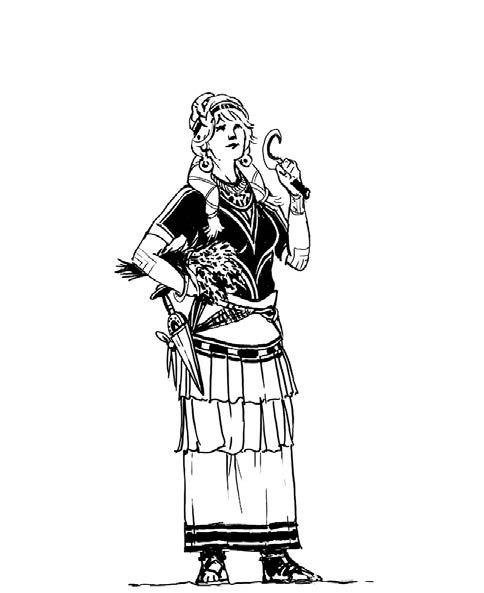
Dragon Pass Priestess
Dragon Pass is colder and relatively poorer than Esrolia. This priestess wears a costume similar to the Esrolian priestess, but adapted for the climate and conditions. Her bodice is not fully opened to reveal the breasts and is looser than the Esrolian version. Her skirt is also more practical than the Esrolian bell-shaped skirt.
Relationships
Abilities can also be used to represent relationships with NPC’s, Organizations, and similar. These abilities can allow a player to perform actions that would be difficult, inconvenient, or impossible to do with only their own personal abilities.
Supporting Characters
These are characters controlled by the Game Master that you are connected with in some way by one of your abilities. In order to leverage your relationship, it’s not as easy as just asking them to do a thing for you. Instead you have to contest with your relationship ability in order to see if they will help solve the problem.
Generally you don’t want to delegate things too much: The heros the players control should be the center of the action and the main doers of deeds whenever possible, and Game Masters should try to curb over-reliance on supporting characters. Two ways to do this are either by high difficulty for repeated requests, they have their own stuff to do and won’t always be able or willing to help, and by putting the characters at risk due to the players actions.
In the risk case, the player may lose that relationship totally, the ability being removed from their character sheet. This could represent the supporting character dying, turning against the players, severing the relationship, etc. The GM should always clearly communicate to players when a Relationship is at risk like this, so they know the possible consequences of relying on others.
Noblewoman
This Esrolian noblewoman wears a close-fitting tube dress, sewn at the side, and held up by two straps that attach behind the neck. The straps come together at the front and expose her breasts. The dress is made of fine linen or even silk. She wears a white-feathered cape over her shoulders.
There are several kinds of Supporting Character that you can have a Relationship ability with:
-
Allies are essentially NPC Heroes. They are considered to be on the same “level” of skill and accomplishment as the player heroes. Relationships with Allies are almost always a two-way-street, of give and take. In a story these would be the special guest stars and crossovers, as each Ally should be worthy of being a PC Hero themselves.
Patrons are you bosses. These are people of higher rank who hold some authority or influence over the players. They may be a legal authority, financial, religious, or just be a friend who’s super important in society. Patrons can wield influence and power far in excess of your typical hero, but reasonably expects you to fulfill some quid-pro-quo if you expect them to do favors for you. Serving a Patron well directly affects how difficult using the relationship is going to be.
Contacts
These are your specialists, NPC’s with a specific role or ability useful to the players who are generally neutral or at best professionally cordial. Business partners, academic experts, skilled artisans, etc fall under this category, and they generally expect payment in some form for their services rendered.
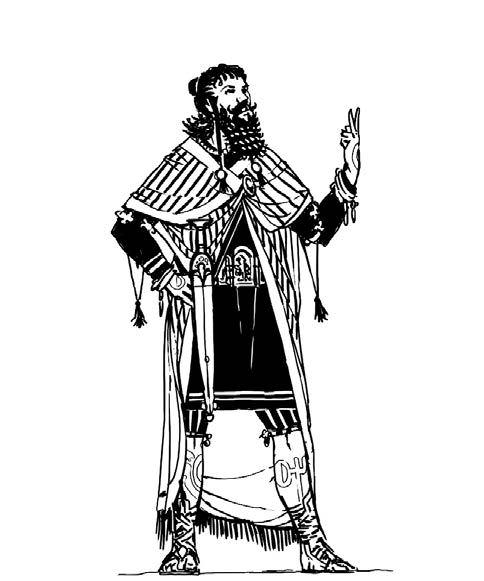
Tarshite Noble
This nobleman from the capital city of Furthest is the height of Provincial aristocratic fashion. His long beard is well groomed, and has been curled with tongs to create hanging curls. He wears a long tunic that goes down to above his knees and leggings for riding. Over that he wears a long embroidered robe that goes down to his ankles, and has been split for riding.
Followers
These are secondary characters that travel with the heros, generally forming a permanent part of the retinue and party. These are your hirelings, sentient weapons, spirit guardians, faithful manservants, and animal companions.
-
Companions
These are specific developed characters under the players control who act essentially as an extension of your hero. This is where you get your faithful animal companions, favorite mounts, faithful sidekicks, magical guardians, talking swords, and so on.
Companions are built essentially as mini-characters. They start with three abilities, one at 17 and the other two at 13. You can then spend 15 points between the three abilities, spending no more than 10 on any one. These are then improved the same as any other of your Hero’s. Companions can be lost through death, or by breaking off the relationship in some way. You can create a new companion if you lose them, or partake in adventure to revive or retrieve the one you lost.
Retainers
These are your traditional Hirelings. Faceless servants or helpers, these aren’t important enough to be proper NPC’s and generally act only to augment other abilities with their aid. This are your bodyguards, miscellaneous spirits, baggage handlers, ship crew, and so on.
